You are using an out of date browser. It may not display this or other websites correctly.
You should upgrade or use an alternative browser.
You should upgrade or use an alternative browser.
Solid state propulsion: a ramjet aircraft WI
- Thread starter Hendryk
- Start date
that are wonderfull Picture by Jozef Gatial
but most of them are post WW2 Aircraft
staate of the art was in 1918, this plane Caproni Ca.40
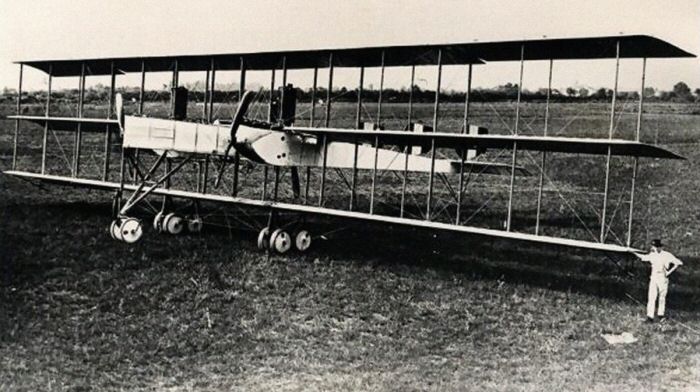
Italy heavy Bomber from WW one
why this ? is had payload of 1500 kg (like mass of biplane fighter aircraft )
(france had no heavy Bomber like that)
so Caproni Ca.40 can take ramjet plane up and drop at speed of 140 km/h (76 knots, 87 mph)
in high of 3000 m (9845 ft)
so to problem of "WWI-era planes being made mostly of wood and canvas"
German Empire build this:

Junkers J1 the world's first practical all-metal aircraft. from 1915
weight of 1170 kg
those two were a good base for French carrier aircraft & ramjet fighter
but most of them are post WW2 Aircraft
staate of the art was in 1918, this plane Caproni Ca.40

Italy heavy Bomber from WW one
why this ? is had payload of 1500 kg (like mass of biplane fighter aircraft )
(france had no heavy Bomber like that)
so Caproni Ca.40 can take ramjet plane up and drop at speed of 140 km/h (76 knots, 87 mph)
in high of 3000 m (9845 ft)
so to problem of "WWI-era planes being made mostly of wood and canvas"
German Empire build this:

Junkers J1 the world's first practical all-metal aircraft. from 1915
weight of 1170 kg
those two were a good base for French carrier aircraft & ramjet fighter
Last edited:
Hendryk
Banned
In aesthetical terms, this one would be my favorite.Still another ramjet paper project, the Nord Aviation Super Griffon
sorry i made mistake
had understand that the Ram Jet had to be "as soon as possible" ready
here a radical concept from 1950
SNECMA AP507E
a VTOL Interceptor with ringwing and Ramjet for Mach 3

had understand that the Ram Jet had to be "as soon as possible" ready
here a radical concept from 1950
SNECMA AP507E
a VTOL Interceptor with ringwing and Ramjet for Mach 3
sorry i made mistake
had understand that the Ram Jet had to be "as soon as possible" ready
here a radical concept from 1950
SNECMA AP507E
a VTOL Interceptor with ringwing and Ramjet for Mach 3
That is probably, for all practical purposes, a manned SAM.
Ramjet- or pulsejet-powered suicide planes
Once an airforce's leadership has decided to build suicide planes, ramjets or pulsejets are an obvious choice for the powerplants, due to their low price compared to piston or turbine engines.
This picture shows the Messerschmitt Me328, which was at first intended to be a parasite fighter and later a suicide plane. Although different ways of installing the pulsejets on the rear fuselage or under the wings were tried, vibrations from these engines tended to destroy the plane's light wooden airframe.

After the Me 328's unsuitability had been discovered, the role of suicide attacker was given to the Fieseler Fi103 Reichenberg, (see below) a manned version of the V-1 'buzz bomb'. Although the Fi 103 R was built and seemed to have fewer problems than the Me 328, it was never used operationally, although the Luftwaffe used suicide tactics with conventional piston engined planes against American bombers and Soviet-held bridges during the last weeks of World War II.
There also was a Japanese pulsejet-powered suicide plane with the same layout as the Fieseler Fi 103 R Reichenberg, the Kawanishi Baika.

Once an airforce's leadership has decided to build suicide planes, ramjets or pulsejets are an obvious choice for the powerplants, due to their low price compared to piston or turbine engines.
This picture shows the Messerschmitt Me328, which was at first intended to be a parasite fighter and later a suicide plane. Although different ways of installing the pulsejets on the rear fuselage or under the wings were tried, vibrations from these engines tended to destroy the plane's light wooden airframe.

After the Me 328's unsuitability had been discovered, the role of suicide attacker was given to the Fieseler Fi103 Reichenberg, (see below) a manned version of the V-1 'buzz bomb'. Although the Fi 103 R was built and seemed to have fewer problems than the Me 328, it was never used operationally, although the Luftwaffe used suicide tactics with conventional piston engined planes against American bombers and Soviet-held bridges during the last weeks of World War II.
There also was a Japanese pulsejet-powered suicide plane with the same layout as the Fieseler Fi 103 R Reichenberg, the Kawanishi Baika.
Last edited:
Luft '46 ramjet- or pulsejet-powered fighters and ground attackers
Luftwaffe projects for ramjet- or pulsejet powered warplanes were legion.
The Heinkel He 162 B-1 was a variant of the turbojet-powered He 162 A Salamander lightweight fighter. It was equipped with two Argus As 014 pulsejets and is rumoured to have actually flown during the last weeks of the war. Here vibrations from the pulsejets also caused major problems. Another variant was equipped with a single, more powerful As 044 pulsejet. Both variants are shown below:
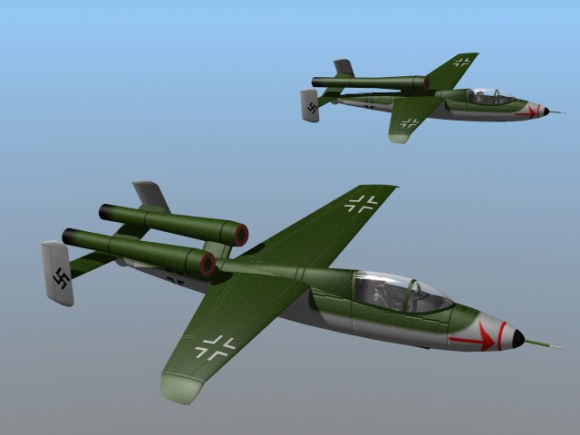
A plane with a similar layout was the Junkers EF 126 ground attacker, it was to be powered by an Argus As 044 pulsejet, only a mock-up was built. More CGs of this plane and information can be found here http://www.luft46.com/ksart/ks126.html
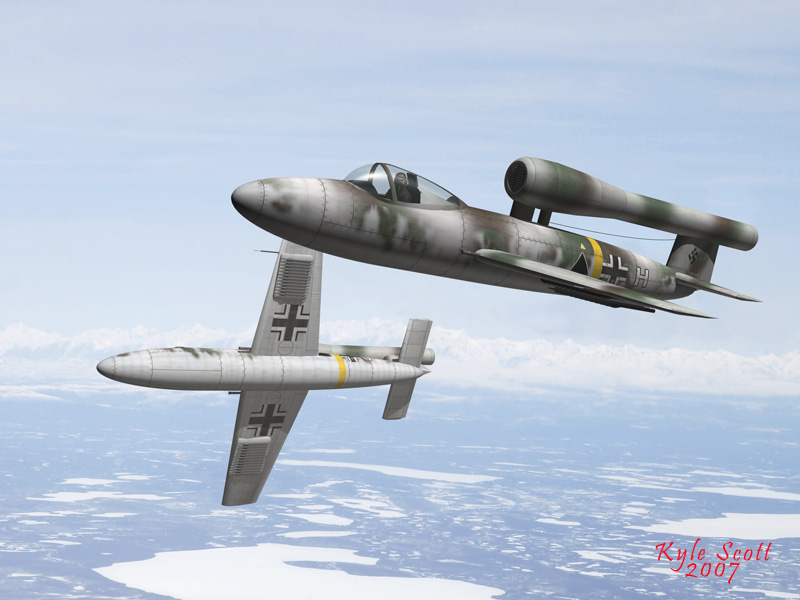
The following three planes are ramjet-powered interceptors which remained paper projects: Focke Wulf FW 283
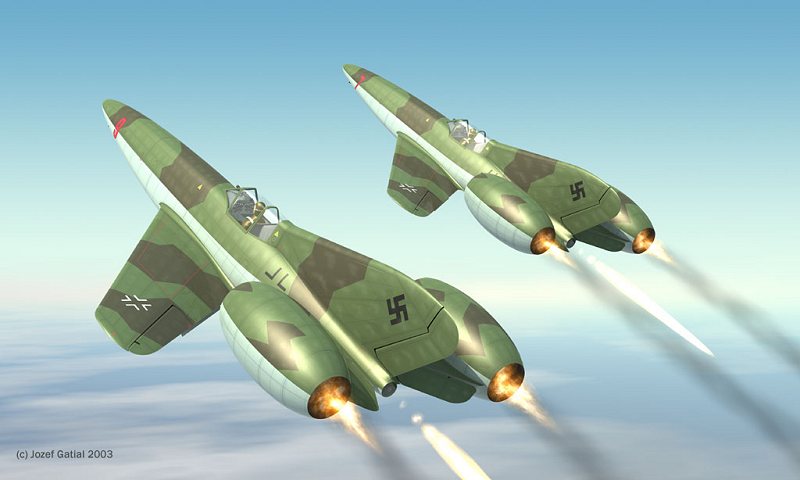
Skoda-Kauba SK P-14.01
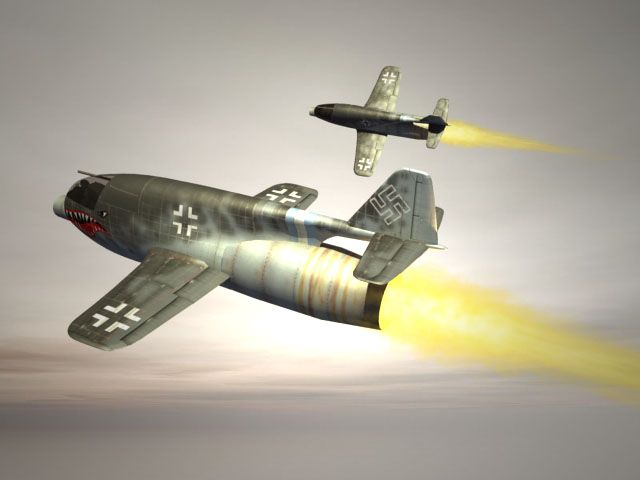
While the Skoda-Kauba SK P.14.01 in the background of the picture below was never built, the plane in the foreground is a Dornier Do 217 medium bomber, which was in fact mass-produced and used as a testbed for various ramjets or pulsejets. It was also used as a carrier aircraft during trials with the Messerschmitt Me 328 parasite fighter / suicide plane.
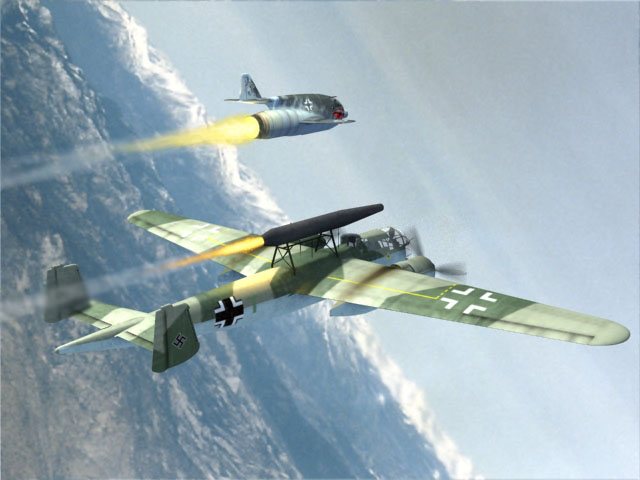
The Heinkel P.1080, like the other two interceptors shown above, was to use rocket power during acceleration and take-off. While the Focke-Wulf FW 283 was to feature a retractable undercarriage, the Skoba-Kauba SK P. 14.01 and the Heinkel P.1080 were to take off on jettisonable trolleys and use extendable skids for landings. A similar procedure was used for the Messerschmitt Me 163 rocket fighter and early reconnaissance versions of the Arado Ar 234, both of which were actually built.
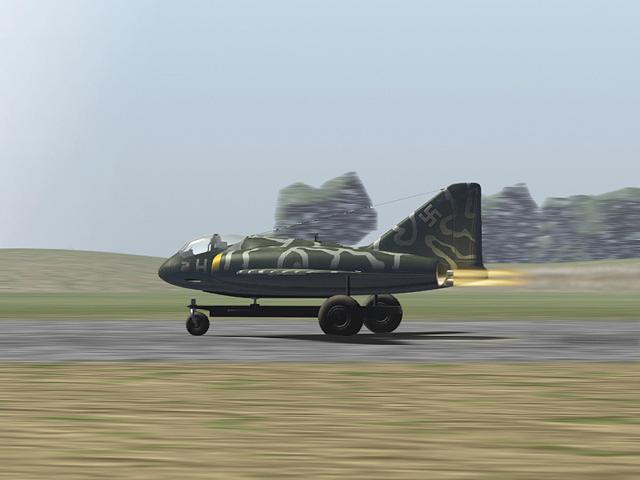
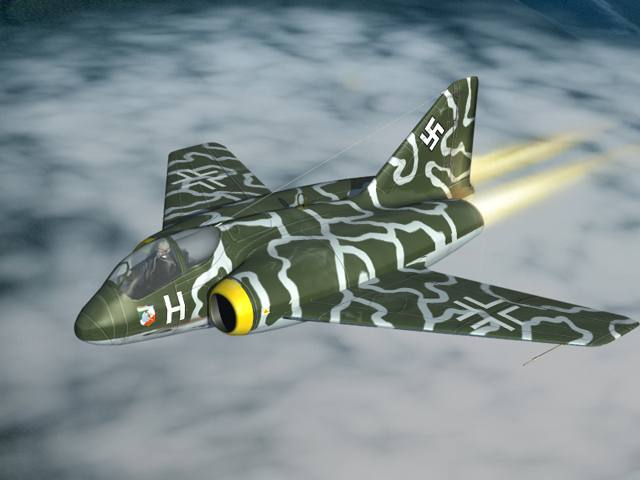
Luftwaffe projects for ramjet- or pulsejet powered warplanes were legion.
The Heinkel He 162 B-1 was a variant of the turbojet-powered He 162 A Salamander lightweight fighter. It was equipped with two Argus As 014 pulsejets and is rumoured to have actually flown during the last weeks of the war. Here vibrations from the pulsejets also caused major problems. Another variant was equipped with a single, more powerful As 044 pulsejet. Both variants are shown below:

A plane with a similar layout was the Junkers EF 126 ground attacker, it was to be powered by an Argus As 044 pulsejet, only a mock-up was built. More CGs of this plane and information can be found here http://www.luft46.com/ksart/ks126.html

The following three planes are ramjet-powered interceptors which remained paper projects: Focke Wulf FW 283

Skoda-Kauba SK P-14.01

While the Skoda-Kauba SK P.14.01 in the background of the picture below was never built, the plane in the foreground is a Dornier Do 217 medium bomber, which was in fact mass-produced and used as a testbed for various ramjets or pulsejets. It was also used as a carrier aircraft during trials with the Messerschmitt Me 328 parasite fighter / suicide plane.

The Heinkel P.1080, like the other two interceptors shown above, was to use rocket power during acceleration and take-off. While the Focke-Wulf FW 283 was to feature a retractable undercarriage, the Skoba-Kauba SK P. 14.01 and the Heinkel P.1080 were to take off on jettisonable trolleys and use extendable skids for landings. A similar procedure was used for the Messerschmitt Me 163 rocket fighter and early reconnaissance versions of the Arado Ar 234, both of which were actually built.


Hendryk
Banned
The pilot of such a plane would dearly hope he didn't have to eject--by the looks of it, he'd end up sucked into the jet intake.A plane with a similar layout was the Junkers EF 126 ground attacker, it was to be powered by an Argus As 044 pulsejet, only a mock-up was built. More CGs of this plane and information can be found here http://www.luft46.com/ksart/ks126.html[/IMG]
That one seems the most realistic-looking of the bunch. Of course, realism be damned, in our heart of hearts we all prefer the good old flying wing design, like the Kayaba Katsuodori you mentioned earlier.The Heinkel P.1080, like the other two interceptors shown above, was to use rocket power during acceleration and take-off. While the Focke-Wulf FW 283 was to feature a retractable undercarriage, the Skoba-Kauba SK P. 14.01 and the Heinkel P.1080 were to take off on jettisonable trolleys and use extendable skids for landings. A similar procedure was used for the Messerschmitt Me 163 rocket fighter and early reconnaissance versions of the Arado Ar 234, both of which were actually built.
Republic XF-103, a competitor in the US Air Force "1954 interceptor" competition. Forward visibility was to be achieved by means of a periscope, take-off and flight up to Mach 2 was to be under turbojet power, after that internal ramps were to be closed that ducted the air to a ramjet. Speeds of Mach 3 and beyond were envisioned. The plane was to be built largely of Titanium. Problems with the engine were so great that development of the plane did not progress much beyond the mock-up stage and the Convair F-102 Delta Dagger and Convair F-106 Delta Dart were built for the interceptor role for which the XF-103 Thunderwarrior was intended.

Last edited:
Hendryk
Banned
Ooh, beautiful thing.Republic XF-103, a competitor in the US Air Force "1954 interceptor" competition. Forward visibility was to be achieved by means of a periscope, take-off and flight up to Mach 2 was to be under turbojet power, after that internal ramps were to be closed that ducted the air to a ramjet. Speeds of Mach 3 and beyond were envisioned. The plane was to be built largely of Titanium.
Reminds me of the Espadon (Swordfish) from the classic graphic novel series "Blake and Mortimer":
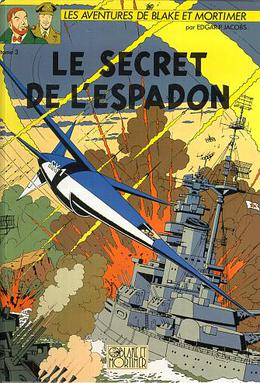
Archibald
Banned
The Romanian fellow was that Coanda guy. The Coanda-1910 aircraft had a motorjet. It set itself on fire during the first taxi test, but at least Coanda figured out the Coanda effect as a result. (Fluid flows stick to surfaces. Put the bowl of a spoon in a narrow stream of water from the tap...)
Aaaah, the Motorjet! One of my favourite early-aviation whatif....
Basically an early turbojet, the compressor being driven by a piston engine.
I admit that the system was rather heavy and unefficient.
But it could be fun having an Alt-history in which Coanda efforts are successfull, leading to motorjet in WWI and interwar.
I had imagined a Fairey Hendon (this british biplane bomber of 1935) with motorjet instead of piston engines and props.
About ramjet, the Spads reached 450 kph in dive. Not too far from ramjet inition speed...
I remember the soviet build an I-16 with two ramjets underwings in 1940.
Could be fun having a similar Spad...
The Caproni Campini N.1 motorjet plane - although Italian propaganda at the time made much of this as the "first jet plane" it was in fact much slower than contemporary piston engined fighters.

An Italian project for a piston engine / motorjet high altitude fighter, the Caproni Ca 183bis. It had an Alfa-Romeo Tifone (license-built Daimler-Benz DB 605) in-line engine of 1,250 hp in the nose, driving a six-bladed counter-rotating propeller. In mid-fuselage there was a 700 hp Fiat A.30 radial engine driving the compressor for the motorjet turbine. Armament was to be four 20mm cannon in the wings plus one 20mm cannon firing through the propeller hub. More information on this and other Italian fighter projects can be found here: http://worldatwar.net/chandelle/v3/v3n1/italtwin.html


An Italian project for a piston engine / motorjet high altitude fighter, the Caproni Ca 183bis. It had an Alfa-Romeo Tifone (license-built Daimler-Benz DB 605) in-line engine of 1,250 hp in the nose, driving a six-bladed counter-rotating propeller. In mid-fuselage there was a 700 hp Fiat A.30 radial engine driving the compressor for the motorjet turbine. Armament was to be four 20mm cannon in the wings plus one 20mm cannon firing through the propeller hub. More information on this and other Italian fighter projects can be found here: http://worldatwar.net/chandelle/v3/v3n1/italtwin.html

The Luftwaffe's CGI Strikes Again!
Looking at those diagrams, I think the best argument for having a ramjet is that the propulsion exhaust looks awesomely Star Wars-ish
I hope you find nothing wrong with either CGs or Luft '46 projects.
I, for one, certainly don't!
On the other hand, liking CGs of aircraft projects is one thing, and believing that they would have worked is another (although, believe it or not, a certain number of Luft '46 projects would have worked)
Here is my favourite of the "realism be damned" (as Hendryk so aptly put it) school of aircraft design, a ramjet-powered tailsitter VTOL project, the Focke-Wulf Triebflügel.
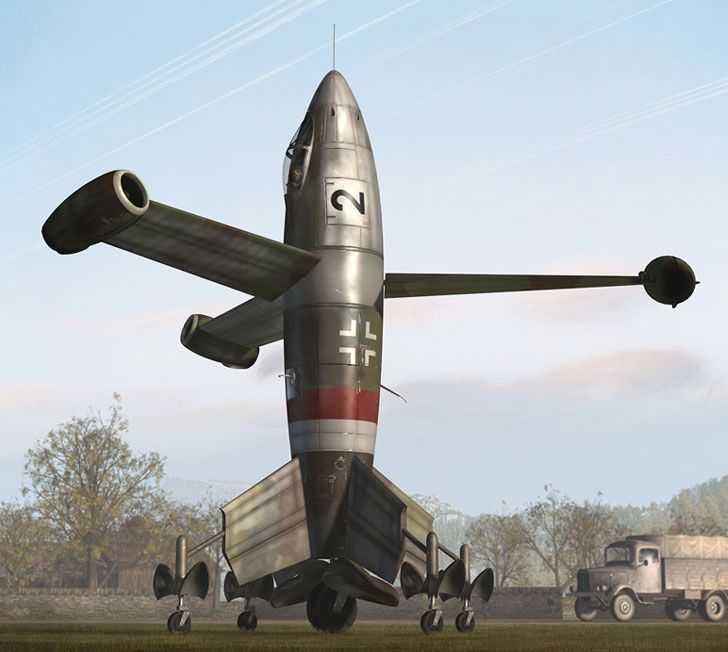
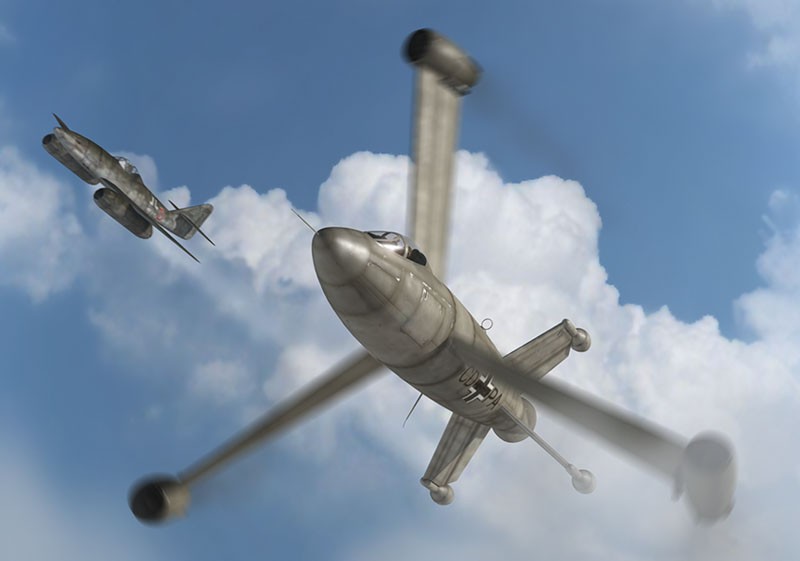
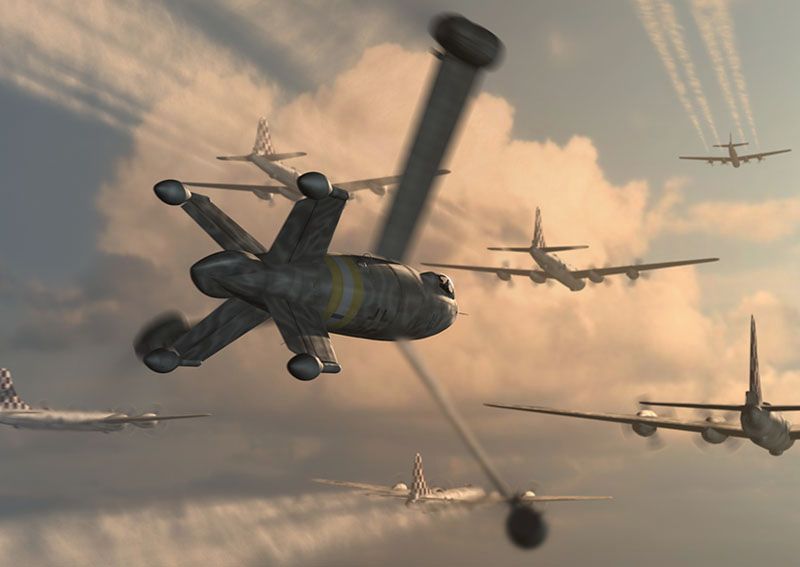
Or... or...
A giant ramjet-propelled robotic-flying spider with 40mm machine guns on each leg
I'd like to see that
Did someone mention the BI-1 with the tip-mounted ramjets? (or was it pulsejets?)
Again, here's the thing about most of those interceptors, especially the point-defense models...sure, SAMs didn't lead to interceptors being eliminated outright, but they did render a lot of projects honestly superfluous and mostly eliminated point-defense interceptors as a class.
The Campini-Caproni aircraft were motorjets. That's a different class of engine than a ramjet. Oh, wait, already mentioned.
Wasn't the Skoda Kauba designed to use coal slurry as fuel, because kerosene and other potential conventional aviation fuels were in such horribly short supply?
(Ramjets would use kerosene, right?)
Again, here's the thing about most of those interceptors, especially the point-defense models...sure, SAMs didn't lead to interceptors being eliminated outright, but they did render a lot of projects honestly superfluous and mostly eliminated point-defense interceptors as a class.
The Campini-Caproni aircraft were motorjets. That's a different class of engine than a ramjet. Oh, wait, already mentioned.
Wasn't the Skoda Kauba designed to use coal slurry as fuel, because kerosene and other potential conventional aviation fuels were in such horribly short supply?
(Ramjets would use kerosene, right?)
Share: